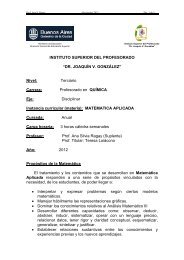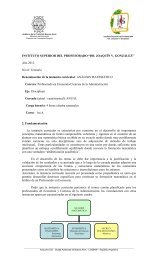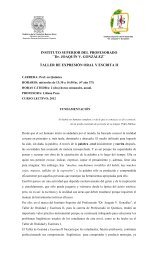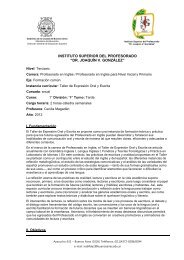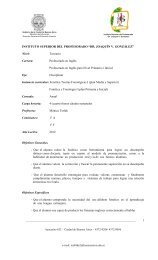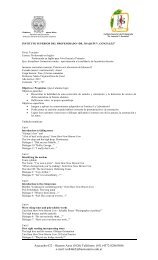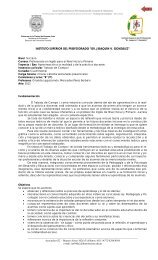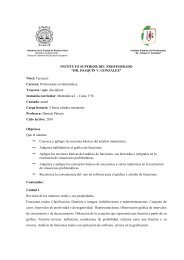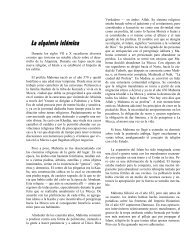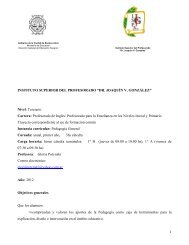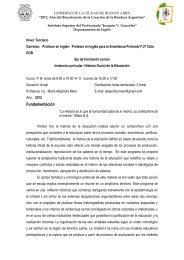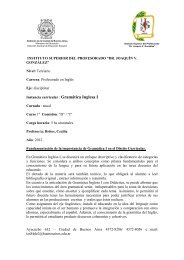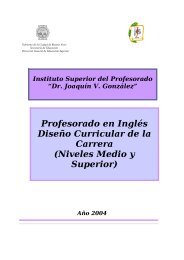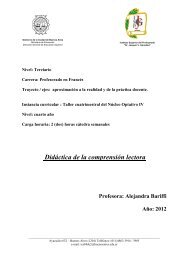Sesiones parale<strong>la</strong>s / Parall<strong>el</strong> sessionsaños <strong>la</strong> T<strong>en</strong><strong>en</strong>cia <strong>de</strong> Carabineros <strong>de</strong> <strong>la</strong> comuna empieza a operar como c<strong>en</strong>tro<strong>de</strong> <strong>en</strong>cierro y castigo don<strong>de</strong> un número aun in<strong>de</strong>terminado <strong>de</strong> personas fueron<strong>en</strong>cerradas, secuestradas, castigadas y <strong>en</strong> algunos casos ejecutadas pormiembros <strong>de</strong>l Ejército y Carabineros <strong>de</strong> Chile, qui<strong>en</strong>es a<strong>de</strong>más contaron con <strong>la</strong>participación activa <strong>de</strong> civiles simpatizantes <strong>de</strong> <strong>la</strong> junta militar.Lo ocurrido <strong>en</strong> <strong>el</strong> campo chil<strong>en</strong>o durante <strong>la</strong> última dictadura militar es un área<strong>de</strong> estudio aun poco explorada. Las zonas rurales <strong>en</strong> Chile son bastante marginalesa <strong>la</strong> mo<strong>de</strong>rnización que viv<strong>en</strong> <strong>la</strong>s ciuda<strong>de</strong>s, al mismo tiempo que suestructura social posee un fuerte rasgo tradicional -cuya base histórica es <strong>la</strong>Haci<strong>en</strong>da- don<strong>de</strong> <strong>la</strong>s c<strong>la</strong>ses sociales aun están fuertem<strong>en</strong>te divididas según<strong>la</strong> propiedad <strong>de</strong> los medios <strong>de</strong> producción. Este esc<strong>en</strong>ario rural hace que <strong>la</strong>sexperi<strong>en</strong>cias <strong>de</strong> <strong>la</strong> dictadura, <strong>en</strong>cierro y castigo tom<strong>en</strong> un cariz difer<strong>en</strong>te alque conocemos <strong>en</strong> los c<strong>en</strong>tro <strong>de</strong> secuestro <strong>de</strong>ntro <strong>de</strong> <strong>la</strong>s ciuda<strong>de</strong>s o <strong>en</strong> <strong>la</strong>s insta<strong>la</strong>ciones<strong>de</strong> campos <strong>de</strong> conc<strong>en</strong>tración, pues <strong>en</strong> <strong>el</strong> campo hay disputas y t<strong>en</strong>sionesque le son propias. Esta particu<strong>la</strong>ridad pue<strong>de</strong> ser compr<strong>en</strong>dida <strong>de</strong>s<strong>de</strong>y a través <strong>de</strong> los re<strong>la</strong>tos sobre <strong>el</strong> ejercicio <strong>de</strong> <strong>la</strong>s viol<strong>en</strong>cias durante esos años ycómo <strong>en</strong> lo re<strong>la</strong>tado se <strong>en</strong>tre<strong>la</strong>zan y visibilizan re<strong>la</strong>ciones <strong>de</strong> po<strong>de</strong>r incrustadas<strong>en</strong> <strong>la</strong> estructura social <strong>de</strong>l campo chil<strong>en</strong>o.<strong>Los</strong> re<strong>la</strong>tos sobre los sucesos <strong>de</strong>ntro <strong>de</strong> <strong>la</strong> T<strong>en</strong><strong>en</strong>cia y <strong>la</strong> viol<strong>en</strong>cia política ejercida<strong>en</strong> este lugar conti<strong>en</strong>e una fuerte pres<strong>en</strong>cia e importancia <strong>de</strong> <strong>la</strong> tierra y <strong>la</strong>familia como objetos ejes <strong>de</strong> <strong>la</strong> experi<strong>en</strong>cia personal y <strong>de</strong> <strong>la</strong> formación <strong>de</strong> i<strong>de</strong>ntidad,dando a <strong>la</strong> investigación un nuevo <strong>en</strong>foque <strong>de</strong>s<strong>de</strong> don<strong>de</strong> compr<strong>en</strong><strong>de</strong>r losucedido durante <strong>la</strong> última dictadura militar <strong>en</strong> Chile y los años previos a ésta.CALLEGARI, Mil<strong>en</strong>a y MASSIMI, MarinaLas Posibilida<strong>de</strong>s <strong>de</strong> E<strong>la</strong>boración <strong>de</strong>l Trauma <strong>en</strong> <strong>la</strong>Memoria, <strong>la</strong> Viv<strong>en</strong>cia y <strong>la</strong> Cultura <strong>de</strong> una ComunidadJudíaEl trauma psíquico gana cada vez más at<strong>en</strong>ción por parte <strong>de</strong> diversas disciplinas,ya que los <strong>de</strong>sastres, viol<strong>en</strong>cias y ma<strong>la</strong>s condiciones <strong>de</strong> vida afectan <strong>la</strong>vida <strong>de</strong> muchos, directa o indirectam<strong>en</strong>te. Si <strong>el</strong> trauma es social, pue<strong>de</strong> traerconsecu<strong>en</strong>cias para toda una sociedad, pueblo o nación. La <strong>historia</strong> <strong>de</strong>l pueblojudío está marcada por guerras, persecuciones, luchas territoriales, diásporase por <strong>el</strong> Holocausto, persecución nazi que cobró <strong>la</strong> vida <strong>de</strong> seis millones <strong>de</strong>judíos <strong>en</strong> <strong>la</strong> II Guerra Mundial. <strong>Los</strong> acontecimi<strong>en</strong>tos traumáticos <strong>de</strong>l pasadopue<strong>de</strong>n traer consecu<strong>en</strong>cias <strong>en</strong> <strong>el</strong> estilo <strong>de</strong> vida <strong>de</strong> los judíos hoy; <strong>el</strong> trauma sepue<strong>de</strong> propagar a través <strong>de</strong> <strong>la</strong>s propias viv<strong>en</strong>cias <strong>de</strong> los individuos y <strong>la</strong>s manifestacionesculturales pue<strong>de</strong>n ser un medio <strong>de</strong> e<strong>la</strong>boración. El objetivo g<strong>en</strong>eral<strong>de</strong> este trabajo fue analizar <strong>la</strong>s repercusiones <strong>de</strong>l trauma y <strong>la</strong> experi<strong>en</strong>cia<strong>de</strong> <strong>la</strong> memoria vivida y significada <strong>en</strong> <strong>la</strong> vida <strong>de</strong>l individuo que sufrió y <strong>de</strong> sus<strong>de</strong>sc<strong>en</strong>di<strong>en</strong>tes. Más específicam<strong>en</strong>te, <strong>la</strong> viv<strong>en</strong>cia <strong>de</strong> judío(s) sobrevivi<strong>en</strong>te(s) a<strong>la</strong> II Guerra Mundial y <strong>la</strong> percepción <strong>de</strong> sus <strong>de</strong>sc<strong>en</strong>di<strong>en</strong>tes con respecto a <strong>el</strong>lo.Hubo también int<strong>en</strong>ción <strong>de</strong> analizar cómo los miembros <strong>de</strong> <strong>la</strong> comunidad judíaviv<strong>en</strong> <strong>la</strong> memoria colectiva <strong>de</strong>l trauma y su significado <strong>en</strong> sus vidas cotidianas.Para <strong>la</strong>s <strong>en</strong>trevistas fue utilizado <strong>el</strong> método <strong>de</strong> <strong>historia</strong> <strong>oral</strong>, una narrativa lineale individual <strong>de</strong> lo que <strong>el</strong> participante consi<strong>de</strong>ra significativo, <strong>de</strong> acuerdocon <strong>el</strong> tema sugerido. Todas <strong>el</strong><strong>la</strong>s fueron grabadas y transcritas integralm<strong>en</strong>te.El análisis cualitativo fue hecho bajo <strong>la</strong> perspectiva <strong>de</strong> Maurice Halbwachs: <strong>la</strong>memoria ti<strong>en</strong>e al mismo tiempo un carácter individual y uno colectivo, si<strong>en</strong>do<strong>en</strong> parte mol<strong>de</strong>ada por <strong>la</strong> familia y por los grupos sociales. <strong>Los</strong> resultados parcialesapuntan que <strong>la</strong> experi<strong>en</strong>cia <strong>de</strong>l sobrevivi<strong>en</strong>te es percibida <strong>de</strong> maneradifer<strong>en</strong>te por cada <strong>de</strong>sc<strong>en</strong>di<strong>en</strong>te y que <strong>la</strong> memoria es un recurso utilizado parae<strong>la</strong>borar <strong>el</strong> trauma. Más que conclusiones <strong>de</strong>finitivas, hay un horizonte <strong>de</strong> indagacióna ser explorado (Apoyo: CAPES/FAPESP).Psychological trauma is worth of increasing att<strong>en</strong>tion from many disciplines,because disasters, viol<strong>en</strong>ce, and bad living conditions affect many lives, directlyor indirectly. If trauma is social, it would involve more ext<strong>en</strong>sive consequ<strong>en</strong>cesreaching a society, people or nation. The history of Jewish peoplehas be<strong>en</strong> marked by wars, persecutions, territorial disputes, diasporas and theHolocaust, a nazi persecution in which about six million Jews were killed atWorld War II. Traumatic ev<strong>en</strong>ts of the past can bring consequ<strong>en</strong>ces for Jews’lifestyle. Trauma can be diffused by people experi<strong>en</strong>ces, and cultural manifestationcan be a way for e<strong>la</strong>borating it. The g<strong>en</strong>eral aim of this work was toanalyze the impact of trauma and the memory experi<strong>en</strong>ce lived by those whosuffered, as w<strong>el</strong>l as the consequ<strong>en</strong>ces brought to their <strong>de</strong>sc<strong>en</strong>dants. More specifically,the experi<strong>en</strong>ce of jew World War II survivors and their <strong>de</strong>sc<strong>en</strong><strong>de</strong>ntsperception about it. Interviews were performed using an <strong>oral</strong> history method,which is a lineal and individual narrative about what participants consi<strong>de</strong>rsignificant, according to the suggested theme. All the interviews were recor<strong>de</strong>dand transcribed in full. The qualitative analysis was done by the collectivememory perspective of Maurice Halbwachs: memory has at the same time anindividual and a collective scope, being partially shaped by family and socialgroups. Our partial results indicated that survivor’s experi<strong>en</strong>ce is perceived by<strong>de</strong>sc<strong>en</strong><strong>de</strong>nts in differ<strong>en</strong>t ways, and the memory is a resource used to e<strong>la</strong>boratethe trauma. More than a <strong>de</strong>finitive conclusion, there is a horizon for research.The next step of this study is to analyze how the Jewish community memberslive the collective memory of trauma and its meaning in their day-to-day life(Support: CAPES/FAPESP).RODRÍGUEZ, Andrea B<strong>el</strong>énUn recorrido por <strong>el</strong>/los “nosotros”. Las construccionesi<strong>de</strong>ntitarias <strong>de</strong>l colectivo Aposta<strong>de</strong>ro Naval Malvinas<strong>en</strong> <strong>la</strong> posguerra (1983-…)War s are ex treme ev<strong>en</strong>t s that can provoke i<strong>de</strong>ntit y reconf igurationof the subjects that w<strong>en</strong>t through them, by dismantling some parametersof i<strong>de</strong>ntity significant in peace times and building otherscharacteristic of war times. That was the case of the Aposta<strong>de</strong>roNaval Malvinas member s’ dur ing the S outh At<strong>la</strong>ntic Conf lic t, amongwhom the affective bonds built continue ev<strong>en</strong> today.The aim of this article is to historicize the i<strong>de</strong>ntity construction processes ofthe Aposta<strong>de</strong>ro group in the postwar, focusing on the meetings of camara<strong>de</strong>riethat its members have be<strong>en</strong> holding annually since 1983.GOMEZ, Gracie<strong>la</strong> Yo<strong>la</strong>nda y MIRANDA, G<strong>la</strong>dysHu<strong>el</strong><strong>la</strong>s <strong>de</strong> <strong>la</strong> vio<strong>la</strong>ción <strong>de</strong> los <strong>de</strong>rechos humanos <strong>en</strong><strong>la</strong> memoria <strong>de</strong> un sobrevivi<strong>en</strong>te <strong>de</strong>l “Terrorismo <strong>de</strong>Estado”: Margarita CamusLa voz <strong>de</strong> los testimonios <strong>de</strong> situaciones traumáticas <strong>de</strong> un período <strong>de</strong> <strong>la</strong> <strong>historia</strong>reci<strong>en</strong>te <strong>de</strong> nuestro país que marcó a toda una g<strong>en</strong>eración, cobra una granfuerza <strong>en</strong> estos tiempos <strong>de</strong>nominados “<strong>la</strong> era <strong>de</strong>l testigo”.La memoria <strong>de</strong> estos sobrevivi<strong>en</strong>tes se erige como un reto para <strong>el</strong> pres<strong>en</strong>te ypara <strong>el</strong> futuro al tiempo que es consi<strong>de</strong>rada por los sobrevivi<strong>en</strong>tes “como unmandato”, “como un <strong>de</strong>ber” <strong>en</strong> nombre <strong>de</strong> qui<strong>en</strong>es ya no están.En este contexto cobra fuerza <strong>la</strong> voz <strong>de</strong> Margarita Camus, qui<strong>en</strong> perdiera sulibertad luego <strong>de</strong>l Golpe <strong>de</strong> Estado <strong>de</strong> 1976. Esta sanjuanina será arrestada <strong>en</strong>nuestra provincia, <strong>en</strong> ese mom<strong>en</strong>to era estudiante <strong>de</strong> <strong>la</strong> carrera <strong>de</strong> Sociología<strong>de</strong> <strong>la</strong> Universidad Nacional <strong>de</strong> San Juan y empleada <strong>de</strong>l D.A.M.S.U( Obra Social<strong>de</strong> <strong>la</strong> UNSJ), <strong>de</strong> familia <strong>de</strong> reconocida militancia <strong>en</strong> <strong>el</strong> peronismo, su abu<strong>el</strong>oEloy Camus, era <strong>el</strong> <strong>en</strong>tonces gobernador <strong>de</strong>stituido por <strong>el</strong> Golpe De Estado <strong>de</strong>1976. Recupera <strong>la</strong> libertad <strong>en</strong> 1981, <strong>en</strong> calidad <strong>de</strong> “libertad vigi<strong>la</strong>da”.Transitará esta dolorosa experi<strong>en</strong>cia primero por un día <strong>en</strong> <strong>el</strong> Regimi<strong>en</strong>to 22 <strong>de</strong>Infantería <strong>de</strong> San Juan, luego <strong>en</strong> <strong>el</strong> P<strong>en</strong>al <strong>de</strong> Chimbas <strong>de</strong>s<strong>de</strong> noviembre <strong>de</strong> 1976a septiembre <strong>de</strong>l 1977, y <strong>de</strong> ahí paso a <strong>la</strong> Cárc<strong>el</strong> <strong>de</strong> Devoto hasta 1981.<strong>Los</strong> recorridos <strong>de</strong> su memoria nos llevan a transitar esos espacios don<strong>de</strong> <strong>el</strong> dolor,<strong>la</strong> tortura física y psicológica era “moneda corri<strong>en</strong>te”. Su testimonio cobravalor <strong>en</strong> razón <strong>de</strong> que son muy pocos <strong>en</strong> <strong>la</strong> provincia que re<strong>la</strong>tan su dolorosasexperi<strong>en</strong>cias, por lo tanto es una señal que aun habi<strong>en</strong>do transcurrido más <strong>de</strong>tres décadas, los trauma propio <strong>de</strong> <strong>la</strong>s situaciones vividas durante <strong>el</strong> cautiveriohan marcado su vidas personales.Margarita Camus pasado un tiempo <strong>de</strong> “recuperar” su libertad consi<strong>de</strong>ró queera su <strong>de</strong>ber dar a conocer su testimonio para que nunca más ocurran <strong>en</strong> nuestropaís estas situaciones <strong>de</strong> terror. La paradoja <strong>en</strong> <strong>la</strong> vida <strong>de</strong> Margarita Camus,es que recuperada <strong>la</strong> libertad siguió <strong>la</strong> carrera <strong>de</strong> abogacía, y actualm<strong>en</strong>teocupa <strong>el</strong> cargo <strong>de</strong> jueza, este nuevo espacio <strong>la</strong> <strong>en</strong>cu<strong>en</strong>tra como una “militante”<strong>en</strong> pos <strong>de</strong> rescatar <strong>la</strong> memoria.The voice of the testimonies of traumatic situations of a period of the rec<strong>en</strong>thistory of our country that marked an <strong>en</strong>tire g<strong>en</strong>eration, gains str<strong>en</strong>gth in thesetimes <strong>de</strong>nominated “the witness era”.The memory of these survivors erects as a chall<strong>en</strong>ge to the pres<strong>en</strong>t and to thefuture, being at the same time consi<strong>de</strong>red by the survivors “as an or<strong>de</strong>r”, “as aduty” in the name of those ones who are not here anymore.In this context, the voice of Margarita Camus gains str<strong>en</strong>gth. She lost her freedomafter the coup d’état in 1976. This sanjuaninian was arrested in our province.At that time, she was studying Sociology at Universidad Nacional <strong>de</strong> San Juanand was an employee at D.A.M.S.U. (the healthcare system of the UNSJ). Shecame from a family with active participation in Peronismo; her grandfather EloyCamus was the governor removed from his post by the coup d’état in 1976. Sherecovers her freedom in 1981, but it was a “supervised freedom”.She w<strong>en</strong>t through that painful experi<strong>en</strong>ce, first, for a day in the Regimi<strong>en</strong>to 22<strong>de</strong> Infantería in San Juan, and th<strong>en</strong> in Chimbas prison from November in 1976 toSeptember in 1977. After that, she sp<strong>en</strong>t some time in Devoto prison until 1981.The journeys in her memory take us to trav<strong>el</strong> those spaces where the pain andthe physical and psychological torture were everyday issues. Her testimony isextrem<strong>el</strong>y worthy as there are very few people who t<strong>el</strong>l their painful experi<strong>en</strong>-104
Sesiones parale<strong>la</strong>s / Parall<strong>el</strong> sessionsces. Therefore, it is a sign that although three <strong>de</strong>ca<strong>de</strong>s have passed, the traumacharacteristic of the situations lived in captivity have marked their personal lives.Margarita Camus, some time after “recovering” her freedom, consi<strong>de</strong>red thatit was her duty to make her testimony public, so that these terrifying situationsoccur never again in our country. The paradox in Margarita Camus’ life is that,after recovered her freedom, she pursued Law studies and she is curr<strong>en</strong>tly holdingthe post of judge. This new space finds her as an “activist” in pursuit ofrescuing the memory.GÓMEZ ALBENTOSA, FerranHistoria <strong>de</strong> un rumor <strong>en</strong> guerra. El caso <strong>de</strong> <strong>la</strong> “noche<strong>de</strong> los moros” <strong>en</strong> Guardamar <strong>de</strong>l Segura (Alicante,1936)Guardamar <strong>de</strong>l Segura (Alicante, Spain) is a seasi<strong>de</strong> town which remain<strong>de</strong>d atthe Republican rearguard after the failure of the coup d’état by G<strong>en</strong>eral Francoon 18 July 1936. Its popu<strong>la</strong>tion daily life, at the begining of the Civil War, sufferedfrom some changes due to some revolutionary experi<strong>en</strong>cies. However, itsinhabitants’ eveyday life was changed by the spread of a piece of false news.On 28 November 1936, during the night, while Alicante (the capital city) wasbeing bombed, Francoist’s troops, “Franco’s Moors” to be more precise, weregoing to disembark in La Mata (a hamlet of the town). The <strong>la</strong>ck of writt<strong>en</strong> sourcesmakes the <strong>oral</strong> story become the only possible way to analyze the affair weare working on.The aim of this work proposal is, first of all, to stablish the social context inwhich the ev<strong>en</strong>t was <strong>de</strong>v<strong>el</strong>oped. Th<strong>en</strong>, to try to reconstruct the affair andknow the way the spread of that rumour affected the inhabitants. And finally,to analyze the influ<strong>en</strong>ce of rumours in case of a war on a rearguardpopu<strong>la</strong>tion with the int<strong>en</strong>tion of getting some conclusions over this particu<strong>la</strong>raffair.——————————————————————————————————————————————Espacio Virrey Liniers——————————————————————————————————————————————MESA PANEL 8Fundam<strong>en</strong>tos metodológicos para reconstruir <strong>el</strong>pasado <strong>de</strong>s<strong>de</strong> <strong>la</strong>diversidadA cargo <strong>de</strong>: Laura B<strong>en</strong>adibaPan<strong>el</strong>istas: María Luisa Iglesias Hernán<strong>de</strong>z, Arturo Lev AlvarezAbreuCom<strong>en</strong>ta: Juan José GUTIÉRREZ——————————————————————————————————————————————11 a 11.15 – Coffee Break——————————————————————————————————————————————11.15 a 13.15 horasC<strong>en</strong>tro Cultural G<strong>en</strong>eral San Martín——————————————————————————————————————————————Subtema / Subteme 12Migraciones, memorias <strong>de</strong>l exilio, diásporas, y <strong>la</strong>hu<strong>el</strong><strong>la</strong> <strong>de</strong> <strong>la</strong>s fronteras <strong>en</strong> <strong>la</strong> memoria / Migration,Exhile, Disaporas, and Bor<strong>de</strong>r<strong>la</strong>nds.Sa<strong>la</strong> C - Mesa / Session 51Coordinan / Chair: Mario Aya<strong>la</strong> Silvina J<strong>en</strong>s<strong>en</strong>——————————————————————————————————————————————GODERDZISHVILI,TsisanaMigration, Cultural Conflicts and Oral HistoriesInternational <strong>la</strong>bor migration is very topical issue for Georgia since 90-ies ofthe <strong>la</strong>st c<strong>en</strong>tury, wh<strong>en</strong> col<strong>la</strong>pse of the Soviet Union in the country caused economicand political crisis. Despite the fact that the mass migration is a comprisedsocial ph<strong>en</strong>om<strong>en</strong>on, in the country is observed the failure of conceptualun<strong>de</strong>rstanding of the problem, which is rar<strong>el</strong>y within aca<strong>de</strong>mic focus and un<strong>de</strong>rstoodprimarily in economic terms. But in most cases announced economic,sometimes behind the political nature migration motivation exists <strong>la</strong>t<strong>en</strong>tfactors that are caused by cultural features and p<strong>la</strong>ys leading role in push-pullmo<strong>de</strong>l. Here we aim to analyze through human memory how is the constructionof cultural i<strong>de</strong>ntity of migrants and its role in integration process with hostsociety; What are the main <strong>de</strong>terminants of conflicts of cultures. We show thesignificance of <strong>oral</strong> histories pres<strong>en</strong>ting migrants not as “objects” but as “subjects”and providing us with an opportunity to acquire a re<strong>la</strong>tiv<strong>el</strong>y completei<strong>de</strong>a concerning the i<strong>de</strong>ntity of a narrator; discover ev<strong>en</strong> earlier experi<strong>en</strong>ces<strong>de</strong>termined by socio-cultural peculiarities, which subsequ<strong>en</strong>tly formed a motivationfor migration. On the example of the <strong>oral</strong> history of one of the female<strong>la</strong>bor migrants (which will remain the main leitmotif throughout the wholeessay), we will consi<strong>de</strong>r <strong>la</strong>bor migration from the social and cultural point ofview, attempting to show that <strong>la</strong>bor migration <strong>de</strong>eply p<strong>en</strong>etrates cultural dim<strong>en</strong>sions(besi<strong>de</strong>s economic and political dim<strong>en</strong>sions) where it may triggerconflicts at the personal and social lev<strong>el</strong>s.HLADNIK, Mirjam M.I<strong>de</strong>ntity construction in migrants’ narratives and contestednotions of b<strong>el</strong>onging contemporary Europe. Acomparative perspectiveA comparative perspective will be pres<strong>en</strong>ted through two differ<strong>en</strong>t sets ofnarratives, from two differ<strong>en</strong>t contin<strong>en</strong>ts and two differ<strong>en</strong>t historical eras.Two sets of narratives compare life stories of Slov<strong>en</strong>ian migrants and their<strong>de</strong>sc<strong>en</strong>dants in the USA (the period of mass migration 1900-1950) and the lifestories of contemporary migrants and “Others” to Slov<strong>en</strong>ia (a newly in<strong>de</strong>p<strong>en</strong><strong>de</strong>ntcountry since 1991 and a member of EU). The narratives subvert simplebinary positions of b<strong>el</strong>onging (or-or) and show how people negotiate, reviseand r<strong>el</strong>ocate the notions of b<strong>el</strong>onging in the specificity of their experi<strong>en</strong>ces andinterpretations in the particu<strong>la</strong>r social, political and cultural context. The comparisonis the way to grasp the contemporary paranoia of immigration in Europein the historical context of mass emigration out of Europe. In this regard,the migrants’ narratives show, how the contested notion of b<strong>el</strong>onging and therestructuring of i<strong>de</strong>ntities are inher<strong>en</strong>t of the process of transformation of asociety affected by migration, and not only of the individuals and groups ofmigrants. It is not only on the lev<strong>el</strong> of individuals but also on the lev<strong>el</strong> of societiesand states or supra-states (European Union), that we should un<strong>de</strong>rstandthe transformative urg<strong>en</strong>cy of i<strong>de</strong>ntities construction as a tool to change orto reproduce social inequalities and the hierarchies of superiority and inferiority.The narratives of Slov<strong>en</strong>ian migrants to the USA were ma<strong>de</strong> into a docum<strong>en</strong>taryfilm “100% Slov<strong>en</strong>ian” (2005) and parts of it will be shown duringthe pres<strong>en</strong>tation. The narratives of migrants to Slov<strong>en</strong>ia are audio and photomaterial, which will be pres<strong>en</strong>ted in a few excerpts.JOHN, Micha<strong>el</strong>Nostalgia and Reconciliation? Memories of/from aForeign LandLEVI, Amalia S.From Personal Narratives to Collective Memory:Spinning a Web from Oral HistoryEthnic <strong>oral</strong> histories are part of the collective memory of diaspora communities,whose geographic dispersion is reflected in the dispersion of their material,but also of minority popu<strong>la</strong>tions, whose voice has usually be<strong>en</strong> sil<strong>en</strong>cedin memory institutions. With rare exceptions, the creation, transcription, andcuration of these <strong>oral</strong> histories are a sequ<strong>en</strong>ce of nearly monastic acts in iso<strong>la</strong>teduniverses. Only in the minds of scho<strong>la</strong>rs, researchers and <strong>la</strong>y users whoultimat<strong>el</strong>y use archival or museum collections do the rich network of associationsthat were linguistically <strong>en</strong>co<strong>de</strong>d long ago using the spok<strong>en</strong> word againbecome connected. Sur<strong>el</strong>y we can do better. In this paper, we begin to explorethe pot<strong>en</strong>tial for <strong>en</strong>riching transcribed <strong>oral</strong> histories with a rich network oflinks, both to other <strong>oral</strong> histories and to other primary and secondary sourcematerials. Toward this <strong>en</strong>d, we have <strong>de</strong>v<strong>el</strong>oped the Oral History Annotation Assistant,an interactive online tool, to support a manual process of linking specificpassages in a transcript to external resources. As the diversity of onlineprimary and secondary source materials continue to expand, the value andscope of such a tool will continue to grow. We view this manual linking mer<strong>el</strong>yas the starting point for our process of building a set of tools that will h<strong>el</strong>pusers and practitioners alike to draw connections that ultimat<strong>el</strong>y add value toarchival or museum collections, and we are looking towards creating points ofcontact betwe<strong>en</strong> <strong>oral</strong> histories and the Linked Op<strong>en</strong> Data that un<strong>de</strong>rlies theso-called “semantic Web.” Ev<strong>en</strong>tually, while each <strong>oral</strong> history provi<strong>de</strong>s onepath for unveiling memory, this kind of contextualization could create a web ofsuch paths, providing diverse points of contact, both in and out, thus h<strong>el</strong>pingto conceptualize individual narratives as an indisp<strong>en</strong>sable tool for historicalresearch in our networked world.105



